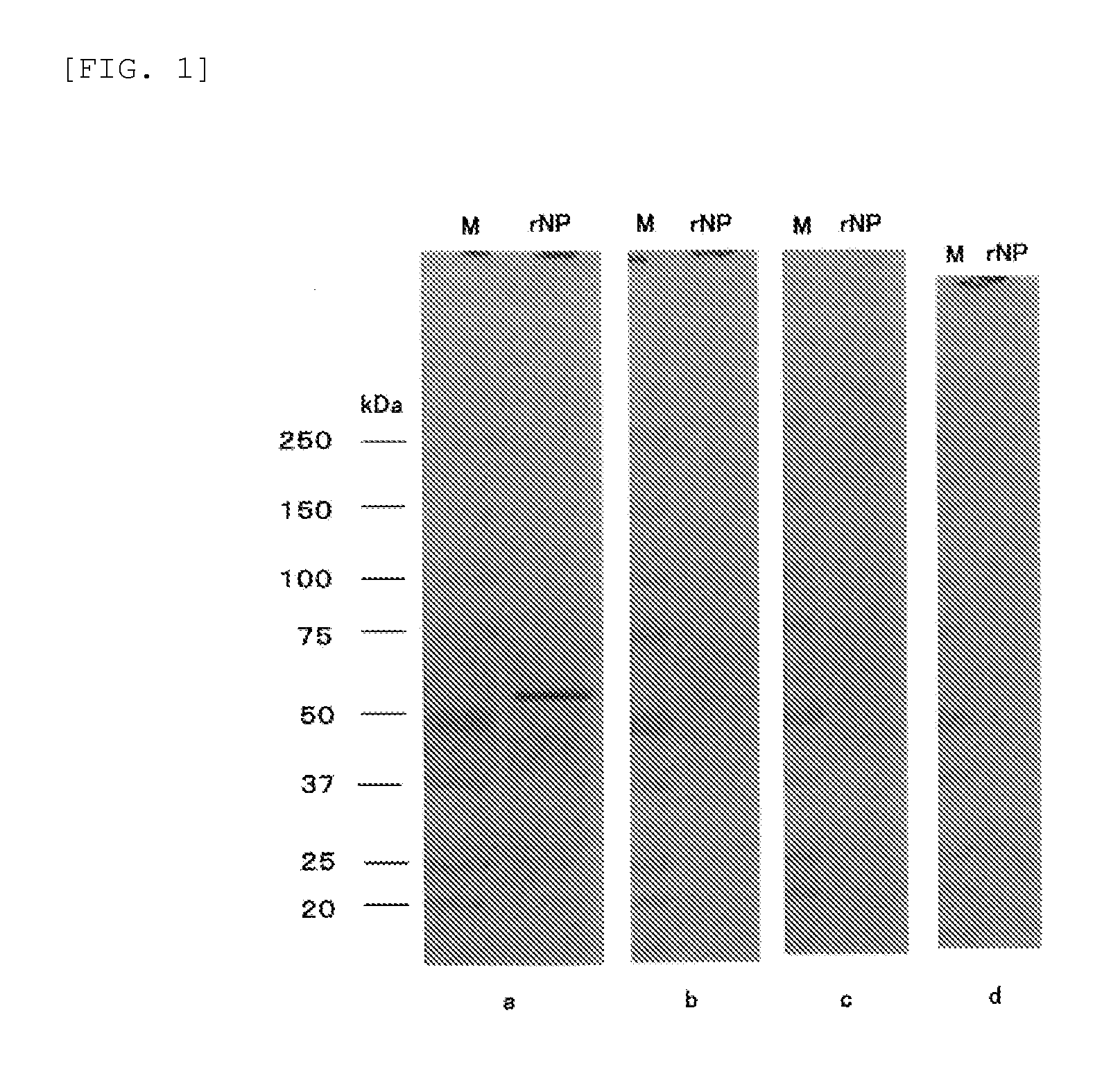Detection kit for influenza a virus
a technology of immunochromatography and kit, which is applied in the field of detection kit for influenza a virus, can solve the problems of inability to obtain accurate determination, inability to obtain accurate diagnosis, and long time-consuming diagnosis, and achieve the effects of reducing the determination of false negative, high detection sensitivity, and high reliability of “negative” determination
- Summary
- Abstract
- Description
- Claims
- Application Information
AI Technical Summary
Benefits of technology
Problems solved by technology
Method used
Image
Examples
example 1
Production of Anti-Influenza A Virus Nuclear Protein Antibody
[0068]A recombinant nuclear protein produced based on the amino acid sequence of a nuclear protein derived from influenza A virus A / Puerto Rico / 8 / 34 (H1N1) strain (DDBJ / GenBank database, Accession No. V01084) was used as the immunogen. An equal parts of complete Freund's adjuvant was added into and completely mixed with the immunogen, and then a BALB / c mouse was immunized 4 times in total at 2-week intervals. Spleen cells were collected from the immunized mouse three days after the last immunization, and hybridomas were produced by the fusion of the spleen cells with myeloma cells (P3U1) using a known standard technique. 10 to 15 days after the production of the hybridomas, the screening for an antibody that is specific to an influenza A virus nuclear protein was performed using a culture supernatant of the hybridoma.
[0069]In the primary screening, an antibody causing an antigen-antibody reaction with the influenza A virus...
example 2
Production of Test Kit by Immunochromatography
(1) Production of Diluent for Capture Antibody
[0074]Isopropyl alcohol was mixed with 50 mM phosphate buffer solution (pH 7.4) so as to be diluted to 5%, and thus a diluent for the first antibody was prepared.
(2) Production of Determination Site on Chromatography Medium
[0075]One antibody, or two antibodies in combination were selected among the antibodies 1C6, 6F7, and 10G5, and diluted with a diluent for a capture antibody so as to have the total antibody concentration of 1.0 mg / mL. The antibody solution was applied on a nitrocellulose membrane (manufactured by Millipore) having a size of 25×2.5 cm using an applicator (manufactured by BioDot), and dried at 50° C. for 5 minutes, then further dried at room temperature for 1 hour, as a result, a determination site was prepared on a chromatography medium.
(3) Production of Labeling Antibody Solution
[0076]A gold colloidal suspension (manufactured by TANAKA KIKINZOKU KOGYO K.K.: average particl...
example 3
Measurement of Influenza A Virus
[0079]Using a test kit produced in the above, a reactivity test with influenza A virus was performed according to the following method, and thus the performance of the test kit of the present invention was examined.
[0080]Nasal mucus was collected from a subject who had been determined to be negative in the infection test of influenza A virus (H3N2) using a PCR method. The collection of nasal mucus was performed as follows: one tube of a suction trap was inserted to the inner part of the nasal cavity of a subject, and the other tube was connected to a suction pump, and the suction pump was set to negative pressure to suck up the nasal mucus. The nasal mucus was diluted 20 fold with a developer, and thus an influenza A virus negative sample was prepared. An inactivated influenza A virus A / Panama / 2007 / 99 (H3N2) was added to the negative sample, and thus an influenza A virus positive sample was prepared.
[0081]150 μL of each of a positive sample and a nega...
PUM
| Property | Measurement | Unit |
|---|---|---|
| molecular weight | aaaaa | aaaaa |
| pH | aaaaa | aaaaa |
| pH | aaaaa | aaaaa |
Abstract
Description
Claims
Application Information
 Login to View More
Login to View More - R&D
- Intellectual Property
- Life Sciences
- Materials
- Tech Scout
- Unparalleled Data Quality
- Higher Quality Content
- 60% Fewer Hallucinations
Browse by: Latest US Patents, China's latest patents, Technical Efficacy Thesaurus, Application Domain, Technology Topic, Popular Technical Reports.
© 2025 PatSnap. All rights reserved.Legal|Privacy policy|Modern Slavery Act Transparency Statement|Sitemap|About US| Contact US: help@patsnap.com

